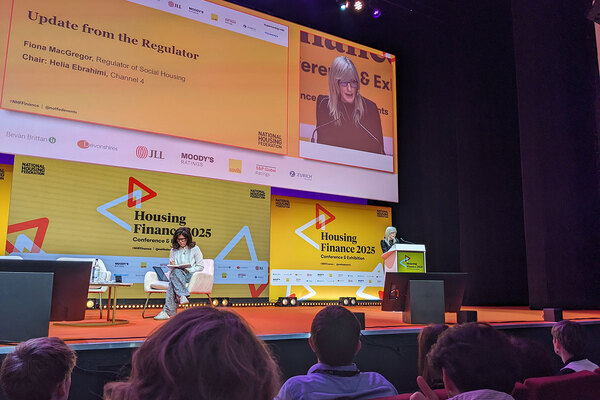Special report: housing associations’ pension surpluses surge
Social Housing analysis has found that housing associations reported a surplus of £125.3m in the last full year of financial reports. Chloe Stothart and Keith Cooper report
- 24 associations reported a total surplus of £125.3m in their pension funds in the last financial year
- 15 of the 24 associations with surpluses had posted a collective deficit of £139.4m in the 2022 financial year
- There was a marked improvement in the net deficit position of associations whose liabilities exceeded their assets by £8m or more in 2023
The number of housing associations posting a pension surplus has risen more than threefold as net deficits have continued to shrink, Social Housing’s latest analysis of associations’ financial accounts has found.
Twenty-four associations reported a total surplus of £125.3m in their pension funds in the latest full set of financial accounts, compared with seven of this group that reported a £12m combined surplus in the previous year. In another stark sign of the turnaround in this group’s apparent pension fund fortunes, 15 of the 24 associations with surpluses had posted a collective deficit of £139.4m in the 2022 financial year.
English associations logged the largest surplus of £77.98m in the year to 31 March 2023, followed by eight providers in Wales with £31.46m. The four Scottish associations in surplus counterparts posted £15.9m.
This analysis looks at the associations with more than 1,000 homes with a deficit of more than £8m or a surplus of any size in 2023.
The analysis also revealed a marked improvement in the net deficit position of associations whose liabilities exceeded their assets by £8m or more in 2022-23. The net deficit of the 32 associations in this group was £537.99m in that reporting period compared with £902.06m in 2022.
The number of associations reporting a net deficit of £8m or more has also fallen markedly over the same period, to 32 in 2023 from 49 the previous year. Only three associations reported deficits over £25m, compared to the eight landlords with negative positions over £55m in our previous report, which looked at 2022. Five of these organisations continued to have a net deficit in 2023.
English associations again account for the majority (96 per cent) of the 2023 total deficit at £519.9m, a 41.1 per cent drop from the £882.3m of the previous year. In contrast, their Welsh counterparts recorded a total deficit of £18.1m in 2023, just 8.3 per cent down on the £19.8m recorded the previous year.
This is Social Housing’s third report on pension deficits that takes into account a 2018-19 change in accounting practices for the Social Housing Pension Scheme (SHPS). Following this change, associations that were members of the SHPS or the Scottish Housing Associations’ Pension Scheme (SHAPS) began presenting their share of these schemes’ total deficits or surpluses in their annual accounts. Prior to the change, landlords had only been able to report their share of Local Government Pension Scheme (LGPS) deficits and surpluses in their accounts.
This meant the 2019 accounts included figures from the LGPS, the SHPS and the SHAPS for the first time, and so provided a baseline across the housing association sector’s defined benefit schemes. Our report on the figures found a deficit of £3.1bn among associations with reported deficits of more than £8m in 2019 and a surplus of £7.3m. Our analysis found a drop in this measure of deficit to £1.9bn in 2022, and an increase in collective surplus to £37m. These earlier reports covered those that had deficits over £8m and surpluses in those years, so cover slightly different cohorts of associations to those that appear in this report.
Associations’ liabilities in their annual accounts are worked out in relation to discount rates based on AA-rated corporate bonds at the year-end date. Consequently, they offer only a limited snapshot in time of their position so do not reflect subsequent market changes. They are also different to the triennial valuations of schemes, which dictate contributions and funding plans.
£77.98m
Surplus at English housing associations in 2023
£31.46m
Surplus at Welsh housing associations in 2023
£15.9m
Surplus at Scottish housing associations in 2023
Our analysis also does not distinguish between the different pension funds used by associations. As each one may respond to changes in inflation and market conditions differently, our figures for collective deficits and surpluses do not necessarily reflect the performance of any individual fund.
Pension experts, however, say that our findings do reflect the general shift in pension fund positions following former prime minister Liz Truss’ Mini Budget in September 2022. “This pushed up interest rates and long gilt yields,” says Steve Simkins, partner at pension advisory firm Isio. “This had different impacts on the LGPS and SHPS.”
“The LGPS is not hedged against interest rate fluctuations. So it ended up in the fantastic position of having assets which maintained their value while liabilities fell significantly.” A lot of associations in the LGPS will have slipped into a surplus, Mr Simkins says. “But SHPS was hedged against interest rate fluctuations, so it did not see its asset values overtake its liabilities. However, liability and asset values both fell and so did deficits.”
English associations included in the analysis posted the largest deficit of £519.9m in 2023, down 41.1 per cent from £882.3m for the same cohort recorded in 2022. In contrast, Welsh associations’ deficit position improved only marginally, from £19.8m in 2022 to £18.1m in 2023. There was one Welsh association and 31 English associations with a net deficit.
The largest deficit in 2023, of £36.5m, was posted by 124,777-home Clarion Housing Group, which was also the largest association by number of units. This represents a more-than doubling of the £14.6m deficit in the previous year and is the biggest decrease in deficit in cash terms. Its 2023 deficit is, however, lower than the £58.5m it posted in 2021.
A spokesperson for Clarion says: “We participate in a number of defined benefit pension schemes (LGPSs and own-name schemes) with each being managed by differing trustees with differing investment strategies. Unfortunately, one of schemes was materially impacted by the significant increase in gilt yields following the Truss Mini Budget in September 2022, an action that impacted many pension schemes across the country.”
The scheme in question used liability-driven investing (LDI), which meant some funds had to quickly raise cash when gilt yields shot up following the Mini Budget.
LDI enables defined benefit pension funds to borrow to invest in gilts – to hedge the interest and inflation risk of their liabilities – and in equities to boost returns and so close their deficit. The funds hold buffers of liquid assets to absorb any losses on the gilts but the steep rise in gilt yields following the mini budget meant losses exceeded that buffer for some funds and they had to raise cash quickly to rebalance. A subset of the LDI market called pooled funds, where a pot of assets is managed for a large number of pension funds, found it especially difficult to raise funds speedily whereas others in different arrangements found it easier to raise money.
Clarion has closed all its defined benefit pension schemes to future accruals, the spokesperson adds. “This will reduce our exposure to the long-term uncertainty and volatility associated with such schemes. We are also working with the scheme trustees to look at the longer-term investment strategy and recovery plan. We will of course continue to fund the scheme and its recovery plan.”
Summary of housing associations’ pension deficits over £8m and surpluses
| Units 2023 | 2023 pension provision (£m) | 2022 pension provision (£m) | 2021 pension provision (£m) | 2020 pension provision (£m) | 2019 pension provision (£m) | Difference 2022 to 2023 (%) | 2023 provision per unit (£) | |
| Total surplus | 182,991 | 125.33 | -127.41 | -253.78 | -141.07 | -182.37 | 198.37* | 684.92 |
| England surplus | 113,152 | 77.98 | -71.29 | -155.66 | -84.56 | -108.82 | 209.38* | 689.13 |
| Scotland total surplus | 14,924 | 15.90 | -0.43 | -10.34 | -3.24 | -11.43 | 3,777.28* | 1,065.63 |
| Wales total surplus | 54,915 | 31.46 | -55.68 | -87.77 | -53.28 | -62.12 | 156.49* | 572.79 |
| Total deficit | 1,729,229 | -537.99 | -902.06 | -1,471.20 | -879.35 | -1,374.98 | 40.36 | -311.12 |
| England deficit | 1,710,895 | -519.85 | -882.29 | -1,430.53 | -858.11 | -1,416.76 | 41.08 | -303.85 |
| Wales deficit total | 18,334 | -18.14 | -19.78 | -40.66 | -21.24 | 41.78 | 8.27 | -989.47 |
| Total deficit and surplus overall | 1,912,220 | -412.66 | -1,029.47 | -1,724.97 | -1,020.42 | -1,557.35 | 59.92 | -215.80 |
Note: data covers associations in England with more than 1,000 units and associations in Wales and Scotland
* = figure was a deficit in 2022 and a surplus in 2023
Abri and Sanctuary Group posted the second and third-largest deficits of £31.6m and £29m respectively. They both declined to comment.
Sovereign Housing Association saw the biggest proportional improvement in its deficit. It dropped 83.1 per cent from £49.3m in 2022 to £8.3m in 2023. Peabody saw the biggest improvement in its deficit in cash terms as it moved from £72m in 2022 to £24m in 2023. On this measure, the 107,449-home London-based landlord had £48m wiped off its deficit in one year. “The improvement is due to market changes and our actuaries adjusting some assumptions, which reduced the total deficit,” a Peabody spokesperson says.
Sovereign Network Group (SNG) said it had five defined pension schemes before its merger with Network Homes in 2023. All five are closed to new members.
“Of these, the Sovereign Pension Plan (SPP) is the largest pension scheme, which has seen a significant reduction of circa £23m in its net liabilities between 2021-22 and 2022-23. This is due to two key factors unique to SPP: SHA’s commitment over the last two years to invest additional contributions of circa £12m during this period to improve the funding level of the SPP and SHA’s investment strategy. The investment strategy focused on investing in growth assets, such as equities, and benefited from equity and gilt market movements during this period,” the spokesperson says.
The spokesperson adds: “Across all five of Sovereign’s defined benefit schemes over the past three years, the percentage fall in pension liabilities was higher than any corresponding fall in pension scheme assets. SNG will continue to take a prudent and proactive view to fund its pension obligations.”
Housing associations with pension deficits over £8m in 2023
| Housing association | Units 2023 | 2023 pension provision (£m) | 2022 pension provision (£m) | 2021 pension provision (£m) | 2020 pension provision (£m) | 2019 pension provision (£m) | Difference 2022 to 2023 (%) | 2023 provision per unit (£) |
| Clarion | 124,777 | -36.50 | -14.60 | -58.50 | -32.30 | -69.30 | -150.00 | -292.52 |
| Abri | 40,878 | -31.60 | -58.15 | -81.03 | -47.23 | -32.02 | 45.66 | -773.01 |
| Sanctuary | 119,695 | -29.00 | -21.60 | -69.10 | -25.90 | -41.40 | -34.26 | -242.28 |
| Peabody | 107,449 | -24.00 | -72.00 | -109.00 | -80.00 | -96.00 | 66.67 | -223.36 |
| Notting Hill Genesis | 67,110 | -23.80 | -24.70 | -44.70 | -22.50 | -58.30 | 3.64 | -354.64 |
| The Guinness Partnership | 64,709 | -23.70 | -60.30 | -84.80 | -40.40 | -91.70 | 60.70 | -366.26 |
| LiveWest | 39,864 | -22.40 | -26.99 | -43.73 | -23.51 | -48.07 | 17.01 | -561.79 |
| Metropolitan Thames Valley | 56,947 | -22.14 | -49.46 | -74.36 | -31.07 | -79.24 | 55.24 | -388.75 |
| L&Q | 108,326 | -22.00 | -25.00 | -42.00 | -25.00 | -44.00 | 12.00 | -203.09 |
| Midland Heart | 34,784 | -21.97 | -22.24 | -35.36 | -17.21 | -44.96 | 1.20 | -631.58 |
| Stonewater | 36,981 | -18.39 | -21.01 | -31.79 | -16.68 | -36.41 | 12.44 | -497.31 |
| Riverside | 76,648 | -18.36 | -26.07 | -35.76 | -21.64 | -49.38 | 29.56 | -239.56 |
| Pobl | 18,334 | -18.14 | -19.78 | -40.66 | -21.24 | 41.78 | 8.27 | -989.47 |
| Longhurst | 24,336 | -16.59 | -20.25 | -21.64 | -12.23 | -29.33 | 18.09 | -681.67 |
| Southern Housing | 77,620 | -16.00 | -24.30 | -13.21 | -8.57 | -9.35 | 34.16 | -206.13 |
| A2Dominion | 39,480 | -15.90 | -24.50 | -37.90 | -16.40 | -33.50 | 35.10 | -402.74 |
| Onward Group | 35,484 | -15.63 | -16.83 | -28.52 | -13.61 | -35.13 | 7.14 | -440.40 |
| Your Housing Group | 27,005 | -15.40 | -14.94 | -38.28 | -17.40 | -39.40 | -3.12 | -570.41 |
| Believe Housing | 18,044 | -15.09 | -57.61 | -70.20 | -52.66 | -44.96 | 73.81 | -836.01 |
| PA Housing | 23,993 | -13.13 | -13.88 | -21.25 | -11.81 | -26.75 | 5.40 | -547.28 |
| GreenSquareAccord | 26,643 | -12.69 | -32.99 | -22.00 | -4.91 | -13.10 | 61.55 | -476.11 |
| Platform Housing Group | 47,997 | -12.39 | -49.96 | -65.84 | -47.91 | -65.91 | 75.19 | -258.22 |
| Great Places Housing Group | 25,474 | -11.64 | -12.37 | -25.38 | -9.48 | -20.31 | 5.88 | -456.94 |
| The Wrekin Housing Group | 13,941 | -10.05 | -55.44 | -60.64 | -50.74 | -42.16 | 81.88 | -720.54 |
| Aster | 36,414 | -9.92 | -16.88 | -41.08 | -32.42 | -45.02 | 41.22 | -272.51 |
| Places for People | 240,129 | -9.50 | -8.70 | -22.40 | -13.10 | -22.10 | -9.20 | -39.56 |
| Nottingham Community Housing Association | 10,157 | -9.34 | -9.84 | -16.33 | -6.92 | -18.57 | 5.10 | -919.27 |
| Network Homes | 22,753 | -8.99 | -6.92 | -12.58 | -5.59 | -17.11 | -29.92 | -395.24 |
| Orbit Group | 47,429 | -8.70 | -6.30 | -22.50 | -13.90 | -32.40 | -38.10 | -183.43 |
| Karbon Homes | 31,771 | -8.59 | -24.40 | -40.93 | -27.98 | -35.50 | 64.81 | -270.31 |
| Sovereign Housing Association | 62,190 | -8.34 | -49.29 | -70.58 | -52.82 | -74.89 | 83.08 | -134.06 |
| Moat Homes | 21,867 | -8.12 | -7.70 | -11.40 | -6.12 | -14.42 | -5.43 | -371.29 |
| Total deficit | 1,729,229 | -537.99 | -902.06 | -1,471.20 | -879.35 | -1,374.98 | 40.36 | -311.12 |
Note: Catalyst merged with Rosebery and then Peabody; Equity merged with Great Places; GreenSquare and Accord merged (2019 and 2020 GreenSquareAccord data is for Accord); Byker and Leeds & Yorkshire HA merged with Karbon; One Housing merged with Riverside; Southern and Optivo merged (data before 2022 is Southern only); Swan merged with Sanctuary
The largest surplus of £15.5m was posted by Saxon Weald, the West Sussex-based association formed from the large-scale transfer of Horsham Council’s council housing in 2000. This surplus is up from £1.9m in 2021-22. In the preceding three years, the association had posted deficits ranging from £310,000 to £5.7m. Saxon Weald’s LGPS is administered by West Sussex Council, according to its accounts. The association did not respond to request for comment.
Three other associations posted net pensions surpluses of more than £10m: Eastlight Community Homes, Scottish Borders Housing Association, and Wales & West Housing.
Of the 24 associations that posted a surplus, Magenta Living’s pension position was the most improved in cash terms. It posted its first surplus in five years of £6.9m in 2023, compared with a deficit of £23.3m in 2022.
A spokesperson for Magenta Living says that the association has “no plans to utilise the surplus” shown in its accounts.
“The value and movement of our defined benefit pension figures are set by the actuaries who oversee the valuation of the pension,” they add. “Several external factors are considered at the time of valuation, which can determine the overall pension financial position, which is changeable at any point in time.”
Pension advisors urged associations with pension funds in surplus to consider now how they might exploit any surplus before a potential deterioration in their position. “In the past, associations with deficits have had to ‘white-knuckle’ their investments, hoping they would outperform; there was no investment strategy decision to make,” Mr Simkins says. “But if you have got a surplus now, there is a decision to make and that is whether or not to derisk.”
He continues: “Nobody anticipated this surplus position and, as is always the case, things could get better or worse from here. You have to ask: what is more important? If you have moved from a deficit that you couldn’t afford, to a surplus, there is likely to be a strong preference for making sure things don’t get worse again.”
Housing associations with pension surpluses in 2023
| Housing association | Units 2023 | 2023 pension provision (£m) | 2022 pension provision (£m) | 2021 pension provision (£m) | 2020 pension provision (£m) | 2019 pension provision (£m) | Difference 2022 to 2023 (%) | 2023 provision per unit (£) |
| Queens Cross Housing Association | 4,510 | 0.04 | 1.16 | -2.57 | -0.07 | -5.09 | -96.51 | 8.98 |
| Hendre | 6,208 | 0.20 | 0.69 | -0.75 | -0.33 | -0.80 | -71.70 | 31.41 |
| Govanhill Housing Association | 2,877 | 0.25 | -0.12 | -1.69 | -0.44 | -1.67 | 301.63* | 86.20 |
| Adra | 6,891 | 0.31 | -7.32 | -11.82 | -4.72 | -5.41 | 104.25* | 45.13 |
| Warrington Housing Association | 1,507 | 1.49 | 0.00 | -1.39 | 0.00 | -1.15 | n/a | 987.39 |
| Tai Calon Community Housing | 6,194 | 2.03 | -15.56 | -22.69 | -14.14 | -19.27 | 113.04* | 327.58 |
| Greatwell Homes | 5,078 | 2.04 | 0.56 | -1.15 | -0.04 | -0.92 | 263.75 | 401.14 |
| Rochdale Boroughwide Housing | 12,427 | 2.09 | -3.61 | -11.31 | -9.91 | -24.90 | 157.94* | 168.26 |
| Melin Homes | 4,635 | 2.56 | -5.40 | -8.93 | -5.26 | -6.83 | 147.46* | 552.97 |
| Parkhead Housing Association | 1,769 | 2.82 | -1.47 | -2.84 | -2.22 | -2.99 | 291.85* | 1,596.38 |
| Beyond Housing | 15,184 | 3.23 | -26.00 | -37.13 | -30.83 | -18.37 | 112.42* | 212.66 |
| Newport City Homes | 9,820 | 3.34 | -19.16 | -25.32 | -13.79 | -16.63 | 117.44* | 340.33 |
| ForHousing | 23,863 | 4.09 | -8.08 | -27.43 | -10.47 | 0.00 | 150.58* | 171.35 |
| Two Rivers Housing | 4,396 | 4.65 | 0.21 | -2.04 | -0.68 | -2.14 | 2,083.10* | 1,057.78 |
| Cartrefi Conwy | 4,530 | 6.11 | -0.17 | -3.94 | -0.76 | -2.61 | 3,735.12* | 1,348.12 |
| East End Homes | 3,920 | 6.12 | 2.88 | 0.01 | 0.46 | -2.58 | 112.31 | 1,561.48 |
| Merthyr Valleys Homes | 4,312 | 6.30 | 4.58 | 0.83 | 0.73 | 4.62 | 37.61 | 1,461.97 |
| Magenta | 12,668 | 6.92 | -23.33 | -31.54 | -20.98 | -24.77 | 129.65* | 546.02 |
| Weaver Vale Housing Trust | 6,480 | 8.44 | -7.64 | -18.49 | -5.47 | -15.03 | 210.56* | 1,302.62 |
| Halton Housing Trust | 7,718 | 9.23 | -4.06 | -10.36 | -1.39 | -5.71 | 327.32* | 1,195.78 |
| Wales & West | 12,325 | 10.60 | -13.34 | -15.16 | -15.01 | -15.19 | 179.47* | 860.37 |
| Scottish Borders Housing Association | 5,768 | 12.79 | 0.00 | -3.25 | -0.51 | -1.67 | n/a | 2,217.58 |
| Eastlight Community Homes | 13,045 | 14.22 | -4.15 | -10.82 | -4.95 | -5.37 | 442.49* | 1,090.07 |
| Saxon Weald Homes | 6,866 | 15.46 | 1.93 | -4.03 | -0.31 | -5.74 | 702.91 | 2,252.26 |
| Total surplus | 182,991 | 125.33 | -127.41 | -253.78 | -141.07 | -182.37 | 198.37 | 684.92 |
Note: Greenfields and Colne merged to form Eastlight. 2019 Eastlight data is Greenfields. n/a = for Colne, the n/a covers years after it merged with Greenfields to form Eastlight. In the case of Warrington and Scottish Borders, n/a is because the organisation had a 0 figure in 2022
* = the housing association had a deficit in 2022 and a surplus in 2023
Mike Richardson, partner and head of social housing practice at LCP, says that financial directors should not let pensions fall off their priority list when they turn a surplus.
“There is a huge amount going on for housing associations with big, important issues such as mould, decarbonisation and fire safety and so the fact that their pensions funding levels have improved may mean pensions has dropped down or off finance directors’ priority list,” he says. “But that means this opportunity to reduce risk could be missed. In many cases there are opportunities to remove risk at a much lower costs then ever thought possible a few years ago.”
Associations could use surpluses to pay future service costs in schemes that are still open or invest their assets in portfolios of corporate bonds and gilts to protect their position, Mr Simkins says. Providers could also “lock in” part of their surplus through partial exits of pensions schemes, or leave them completely, he adds.
Katy Taylor, director at Isio, says that some LGPS funds require a complete exit to realise a surplus. This would involve closing the scheme to current staff and to future accruals for existing members. Different ways of valuing schemes however meant that associations might receive less from realising a surplus than they expect, Ms Taylor adds.
“One association was £10m in surplus with their LGPS in 2024 but the fund changed its way of calculating the value to one that said it was £10m in deficit,” she adds. “The fund would say they are being prudent,” she says, “But we would say that is over funding. Other funds will offer different approaches.”
The move of many more associations into a surplus position should also trigger some “robust discussions” between employers and the LGPS, Mr Simkins says. “Employers should push hard to get what is right for them and right for the fund. More and more associations are having robust discussions with the LGPS about that, but a big challenge for the LGPS now is to find the resources to address this need.”
Mr Richardson adds that exit fees for some associations had plunged in recent years thanks to their improved pension positions. “In many cases the cost of exit has come right down, he adds. “One association we advised was told their exit fee would be £100m three years ago. They ultimately managed to exit last year for less than £10m.”
Ms Taylor says that exit fees for SHPS were less than two years ago because its assets and liabilities had “shrunk by a lot”, making the scheme itself much smaller.
One of the next big milestones for housing association pensions is, of course, the SHPS triennial valuation, which is due to be shared with its members later this year. TPT Retirement Solutions, which administers SHPS, declined to be interviewed for this piece.
Mr Simkins, however, says that market conditions in relation to pensions have been “very good” since March 2023, when they were still considered volatile, six months after the Mini Budget. “The significant inflationary pressures over the past two years have been a negative factor on pension funds but this has been overplayed as higher inflation had been anticipated. Equity markets have improved since 2023 so the LGPS funding position has got even better,” he adds. “Nothing remarkable has happened and the indications are that the markets are likely to be in a ‘new normal’”.
Other recent special reports from Social Housing
Special report: total development income hits £3.8bn
Total development income hit £3.8bn for the year to 31 March 2023, a rise of 3.2 per cent, Social Housing’s analysis of the accounts of 124 UK housing associations has found. Chloe Stothart and Robyn Wilson report
Special report: capital commitments hit £42bn
Planned capital spend among housing associations rose four per cent in the latest full year – a smaller rise than in the previous year. Chloe Stothart and Robyn Wilson report
Special report: net impairments hit record high
Net impairments at UK housing associations rose to a record high of £287.5m in 2023. Chloe Stothart and Robyn Wilson look at individual housing associations’ data and find out what drove the rise in write-offs
Special report: UK staff pay climbs nearly 7% amid rising costs and recruitment challenges
Average staff pay for the largest housing associations in the UK increased by nearly seven per cent in 2023, driven by the cost of living and a shortage of staff
Accounts digest 2023: operating surplus falls 14%
Social Housing’s analysis of registered providers’ 2023 audited accounts finds a continuation of some of the trends of the previous year, with operating margins falling for most organisations
Special report: data shows major four-year rise in temporary accommodation levels
Exclusive analysis by Social Housing has found that the number of households in temporary accommodation in England has risen by nearly a third over the past four years
Sign up for Social Housing’s data analysis newsletter
New to Social Housing? Click here to register and sign up for our data analysis newsletter
The data analysis newsletter is a twice-monthly round-up of Social Housing’s leading data analysis, keeping you up to speed on key trends and pointing you to all the data you need on financial and operating performance in the sector and beyond.
Already have an account? Click here to manage your newsletters.
RELATED









